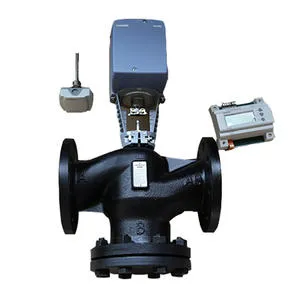With the continuous advancement of industrial technology, automation control systems play an increasingly important role in industrial production. Among many automatic control equipment, self-operating temperature control valves have attracted much attention due to their unique characteristics and wide range of applications. This article will discuss the working principle, application areas, advantages and challenges of self-operating temperature control valves, and future development trends.

1. Working principle and composition
The self-operating temperature control valve is a device that can automatically adjust the valve opening according to the temperature change of the fluid medium to achieve stable temperature control. The core principle is to use a temperature sensor to sense the temperature of the fluid and transmit the signal to the control system. The control system then calculates the corresponding valve opening based on the preset temperature set value, and controls the opening and closing of the valve through the actuator to adjust the fluid. flow, thereby achieving the purpose of temperature control.
2. Application areas
Self-operating temperature control valves are widely used in many industrial fields, including but not limited to the following:
1). Manufacturing: During the manufacturing process, many production environments are very sensitive to temperature, such as metal heating, plastic molding, etc. Self-operating temperature control valves can accurately control the temperature of fluids to ensure product quality and production efficiency.
2). Energy field: In the energy industry, self-operating temperature control valves are used to control heating systems, combustion equipment, etc., to achieve efficient use of energy.
3). Chemical engineering process: In the chemical engineering process, temperature needs to be strictly controlled to ensure the accuracy and safety of the reaction. The self-operating temperature control valve can automatically adjust the temperature according to reaction needs, reducing operator intervention.
3. Advantages and Challenges
Compared with traditional manual control methods, self-operating temperature control valves have the following advantages:
1). Precise control: The self-operating temperature control valve can sense temperature changes in real time, achieve precise temperature control, and avoid production problems caused by temperature fluctuations.
2). Automation: The self-operating temperature control valve can automatically adjust according to the preset set value, reducing manual intervention and improving production efficiency.
3). Safety: In some dangerous environments, self-operating temperature control valves can achieve automatic control, reducing risks to personnel.
However, self-operating temperature control valves also face some challenges:
1). Technical requirements: The design and application of self-operating temperature control valves require knowledge covering multiple fields and require professional and technical personnel for design, installation and maintenance.
2). Cost issue: The construction and maintenance of automated control systems require certain investment costs, especially in the initial stage.
4. Future development trends
With the rapid development of Industry 4.0 and smart manufacturing, self-operating temperature control valves are expected to develop in a more intelligent and intelligently networked direction. Future development trends may include:
1). Intelligent control: Self-operating temperature control valves will place more emphasis on adaptive control capabilities and can make intelligent adjustments based on historical data and real-time information to improve control accuracy.
2). Remote monitoring: With the development of Internet technology, self-operating temperature control valves may realize remote monitoring and remote control, improving the flexibility of the production process.
3). Energy efficiency: Future self-operating temperature control valves may pay more attention to the efficient use of energy and contribute to sustainable development.
In short, self-operating temperature control valves, as an important part of modern industrial automation, provide intelligent temperature control means for production in various fields. Although it faces some technical challenges and cost issues, its advantages in improving production efficiency, product quality and safety will drive its future development. With the continuous innovation and application of technology, self-operating temperature control valves will continue to play an important role in the industrial field and achieve more intelligent and sustainable production.